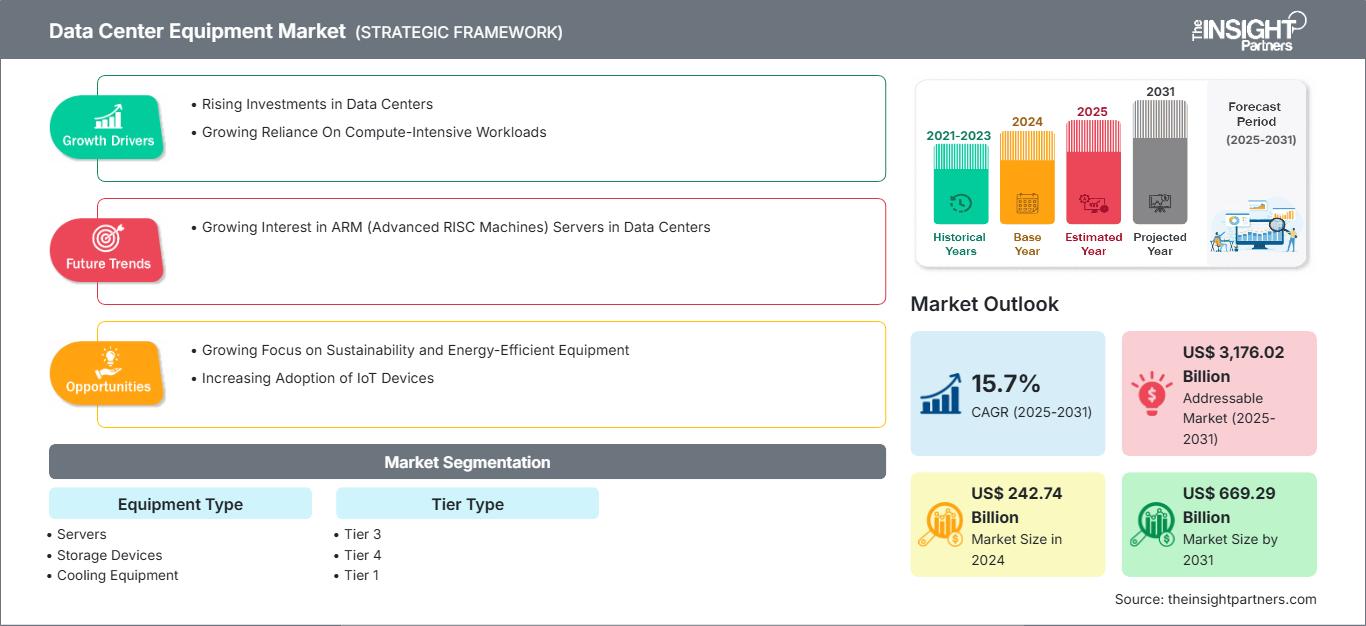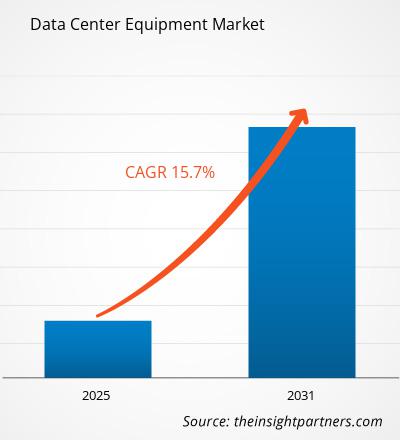2024 年数据中心设备市场规模为 2427.4 亿美元,预计到 2031 年将达到 6692.9 亿美元;预计 2025 年至 2031 年期间的复合年增长率为 15.7%。数据中心对高级 RISC 机器 (ARM) 服务器日益增长的兴趣可能会带来新的市场趋势。
数据中心设备市场分析
近年来,数据中心设备市场经历了显著增长,这得益于对数字服务、云计算和数据存储解决方案日益增长的需求。随着企业和消费者越来越依赖数字平台进行日常活动,对强大、安全和可扩展的数据基础设施的需求也随之增加。数据中心是用于容纳关键 IT 系统和组件(例如服务器、存储系统、网络设备和冷却系统)的设施,已成为支持不断增长的数据量的关键。数据中心设备市场的主要驱动力在于新建数据中心的投资不断增加,以及对计算密集型工作负载的日益依赖。物联网设备的激增以及对可持续性和节能设备的日益关注,预计将为数据中心设备市场的增长提供丰厚的利润。数据中心对高级精简指令集计算机 (ARM) 服务器日益增长的兴趣,很可能成为数据中心设备市场的一个关键趋势。
数据中心设备市场概览
数据中心设备是指存储、处理和管理数据所需的物理基础设施和硬件。这些设备协同工作,确保数据中心能够存储、处理、管理和保护大量数据,并提供可靠的网络服务。数据中心设备的设计注重高耐用性和可靠性,通常包含冗余和故障转移机制,以确保持续的可用性。数据中心的组件能够高效地处理、存储和分发大量数据。数据中心设备包括服务器、存储设备、冷却设备、配电单元 (PDU)、机架和机柜。该设备对于确保数据中心高效、安全且高可用性地运行至关重要。
自定义此报告以满足您的要求
您将免费获得任何报告的定制,包括本报告的部分内容,或国家级分析、Excel 数据包,以及为初创企业和大学提供超值优惠和折扣
数据中心设备市场: 战略洞察

- 获取本报告的主要市场趋势。这个免费样本将包括数据分析,从市场趋势到估计和预测。
您将免费获得任何报告的定制,包括本报告的部分内容,或国家级分析、Excel 数据包,以及为初创企业和大学提供超值优惠和折扣
数据中心设备市场: 战略洞察

- 获取本报告的主要市场趋势。这个免费样本将包括数据分析,从市场趋势到估计和预测。
数据中心设备市场驱动因素和机遇
数据中心投资不断增长
在大数据分析、人工智能、云计算和物联网 (IoT) 的推动下,全球数据的生成和消费呈指数级增长。这需要更多的数据中心来存储、处理和分发这些数据,从而导致对数据中心的投资不断增加。企业正在加大对数据中心基础设施建设和扩展的投资,以满足日益增长的数据存储、处理和管理需求。以下列举一些实例。
- 2025 年 1 月,OpenAI、软银和甲骨文成立的合资企业计划在人工智能基础设施上投资 1000 亿美元,并有可能扩大到 5000 亿美元。这项投资包括建设 10 个数据中心,其中一个已在德克萨斯州阿比林建设中。每个设施占地约 50 万平方英尺(约 46 万平方米)。
- 2025 年 2 月,黑石集团及其开发合作伙伴 Panchshil Realty 计划在新孟买开发印度最大的超大规模数据中心,容量为 500 兆瓦,投资额超过 23 亿美元(约合 2000 亿卢比)。该 500 兆瓦设施将覆盖 14 栋建筑,占地 300 万平方英尺(约 27 万平方米),可再生能源使用率高达 65%。
由于新数据中心建设投资大幅增加,这些设施将需要先进的设备,例如服务器、存储设备、冷却系统和配电单元 (PDU)。这些组件对于有效存储、处理和分发海量数据至关重要,从而推动了数据中心设备市场的增长。
物联网设备采用率不断提高
物联网 (IoT) 指的是一个由互联设备组成的广泛网络,以及实现这些设备与云端通信的技术。近年来,由于移动和无线连接技术的进步,物联网技术的采用率大幅增长。许多行业正在利用物联网来提高效率并降低运营成本。根据 IoT Analytics 发布的《2024 年夏季物联网现状》报告,截至 2023 年底,全球联网物联网设备数量已达 166 亿台,预计到 2030 年,这一数字将增至约 254.4 亿台。IoT Analytics 预测,到 2030 年,全球 75% 的设备将属于物联网设备。
随着物联网设备在智能家居、医疗保健、制造和运输等各行各业的普及,数据处理、存储和管理的需求也随之激增。联网设备的激增直接影响着数据中心设备行业,因为这些设备会生成大量需要实时存储、处理和分析的数据,因此需要强大的服务器、存储解决方案和能够高效处理和管理这些海量数据的网络设备。因此,预计物联网设备的日益普及将为数据中心设备市场的增长提供丰厚的机遇。
数据中心设备市场报告细分分析
促成数据中心设备市场分析的关键细分是设备类型和层级类型。
- 根据设备类型,市场细分为服务器、存储设备、制冷设备、配电单元 (PDU)、机架、机柜等。服务器细分进一步分为机架式服务器、刀片式服务器和塔式服务器。制冷设备细分又细分为空调、冷水机组、空气处理机组、热交换器等。配电单元 (PDU) 细分进一步分为交换式机架 PDU、计量式机架 PDU、监控式机架 PDU 和基本式机架 PDU。机架细分又分为封闭式机架、开放式机架、壁挂式机架等。 2024 年,服务器细分市场占据了市场主导地位。
- 根据层级类型,数据中心设备市场分为 3 级、4 级、1 级和 2 级。2024 年,3 级细分市场占据了市场主导地位。
按地域划分的数据中心设备市场份额分析
- 数据中心设备市场分为五大区域:北美、欧洲、亚太地区 (APAC)、中东和非洲 (MEA) 以及南美和中美。2024 年,北美占据了数据中心设备市场的主导地位。欧洲是全球数据中心设备市场的第二大贡献者,其次是亚太地区。
- 北美的数据中心设备市场分为美国、加拿大和墨西哥。北美在技术创新和采用方面处于领先地位。随着企业扩展其数字基础设施,对数据中心的投资增加刺激了对数据中心设备的需求。这种增长推动了对更强大的服务器、冷却系统和网络设备的需求,以应对日益增长的数据流量和存储需求。该地区的企业正在努力为人工智能和云超大规模业务建立设施。通过创建专用数据中心来满足这些技术对性能、可扩展性和能效的高要求,这一努力推动了市场发展。人工智能 (AI) 工作负载的兴起正在改变数据中心行业,对高耗能基础设施的需求空前高涨。人工智能组织正在迅速影响数据中心的选址、设计和运营需求,并专注于提供可扩展电力容量和创新连接解决方案的市场。例如,2025 年 3 月,美国房地产公司 Related Companies, LP 成立了一个新的数据中心开发部门,并计划在美国和加拿大建设千兆瓦的容量。Related 声称,近期将在美国和加拿大投资 450 亿美元,建设总计 5 千兆瓦的数据中心。由于人工智能和云计算需要大量的计算能力和存储空间,数据中心必须配备尖端的基础设施,例如高密度服务器和先进的冷却系统。这种专业化的关注加速了对数据中心设备(如先进的服务器、网络设备和节能解决方案)的需求,进而推动了市场的增长。
数据中心设备市场
The Insight Partners 的分析师已详尽阐述了预测期内影响数据中心设备市场的区域趋势和因素。本节还讨论了北美、欧洲、亚太地区、中东和非洲以及南美和中美洲的数据中心设备市场细分和地域分布。
数据中心设备市场报告范围
| 报告属性 | 细节 |
|---|---|
| 市场规模 2024 | US$ 242.74 Billion |
| 市场规模 2031 | US$ 669.29 Billion |
| 全球复合年增长率 (2025 - 2031) | 15.7% |
| 历史数据 | 2021-2023 |
| 预测期 | 2025-2031 |
| 涵盖的领域 |
By 设备类型
|
| 覆盖地区和国家 | 北美
|
| 市场领导者和主要公司简介 |
|
数据中心设备市场参与者密度:了解其对业务动态的影响
数据中心设备市场正在快速增长,这得益于终端用户需求的不断增长,而这些需求的驱动因素包括消费者偏好的不断变化、技术进步以及对产品优势的认知度不断提高。随着需求的增长,企业正在扩展其产品线,不断创新以满足消费者需求,并抓住新兴趋势,从而进一步推动市场增长。

- 获取 数据中心设备市场 主要参与者概述
数据中心设备市场新闻及最新动态
数据中心设备市场的评估是通过收集一手和二手研究的定性和定量数据进行的,这些数据包括重要的公司出版物、协会数据和数据库。数据中心设备市场的一些发展如下:
- ABB 收购了北卡罗来纳州公司 DG Matrix 的少数股权,以支持固态电力电子设备的商业化,用于生成式人工智能数据中心和可再生微电网。该公司的 Power Router 平台以一体化解决方案取代了传统系统,该解决方案体积缩小了五倍,并拥有 98% 的一流能效。该投资的财务细节尚未披露。
(来源:ABB,新闻稿,2025 年 3 月)
- 罗格朗宣布收购数据中心基础设施领域的领导者 Computer Room Solutions (CRS)。 CRS 拥有近 20 年的运营经验,是数据中心基础设施设计、开发和调试领域的领先企业。
(来源:罗格朗,新闻稿,2025 年 4 月)
数据中心设备市场报告覆盖范围和可交付成果
《数据中心设备市场规模和预测(2021-2031)》对市场进行了详细的分析,涵盖以下领域:
- 涵盖范围内所有关键细分市场的全球、区域和国家/地区数据中心设备市场规模和预测
- 数据中心设备市场趋势以及市场动态,例如驱动因素、限制因素和关键机遇
- 详细的 PEST 和 SWOT 分析
- 数据中心设备市场分析,涵盖关键市场趋势、全球和区域框架、主要参与者、法规和最新市场发展
- 行业格局和竞争分析,涵盖市场集中度、热图分析、知名参与者和数据的最新发展中心设备市场
- 详细的公司简介
- 历史分析(2 年)、基准年、预测(7 年)及复合年增长率
- PEST和SWOT分析
- 市场规模、价值/数量 - 全球、区域、国家
- 行业和竞争格局
- Excel 数据集
近期报告
客户评价
购买理由
- 明智的决策
- 了解市场动态
- 竞争分析
- 客户洞察
- 市场预测
- 风险规避
- 战略规划
- 投资论证
- 识别新兴市场
- 优化营销策略
- 提升运营效率
- 顺应监管趋势




















 获取免费样品 - 数据中心设备市场
获取免费样品 - 数据中心设备市场